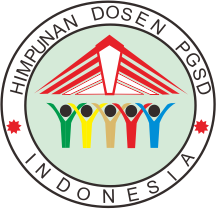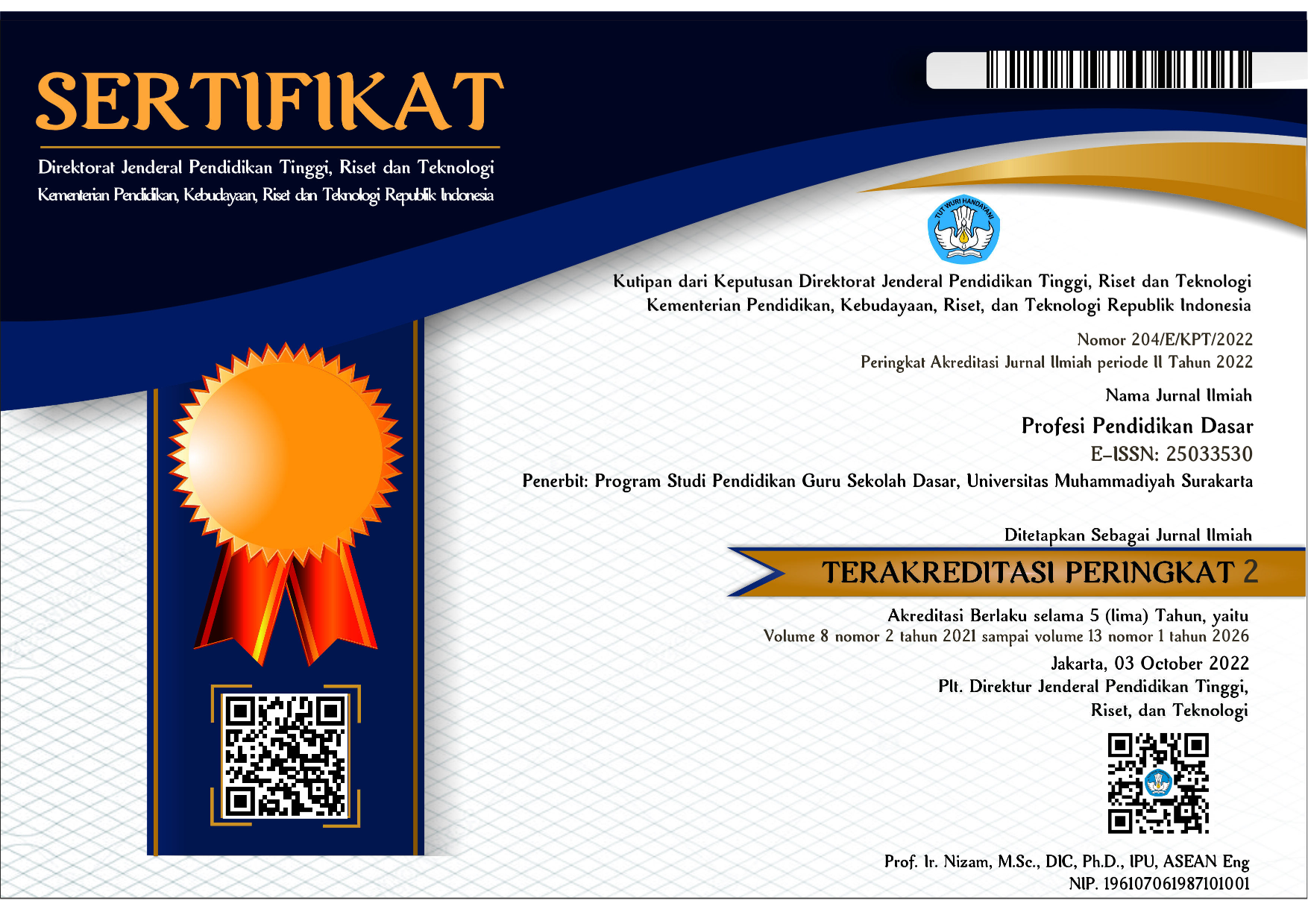PERSEPSI MASYARAKAT DAN DAMPAK SISTEM ZONASI UNTUK PEMERATAAN AKSES SEKOLAH JENJANG SEKOLAH DASAR DI KECAMATAN SERENGAN KOTA SURAKARTA
Wahdan Najib Habiby(1*), Saroh Nur Fiatun(2)(1) (ID SINTA = 6020733) Elementary School Teacher and Education (PGSD), Faculty of Teacher Training and Education (FKIP), Universitas Muhammadiyah Surakarta
(2) Universitas Muhammadiyah Surakarta
(*) Corresponding Author
Abstract
The purpose of this study is to describe: 1) the implementation of school zoning in Serengan Subdistrict, Surakarta City; 2) public perception of the school zoning system of Serengan Sub-District, Surakarta City; and 3) the impact of the zoning system in Serengan Subdistrict, Surakarta City. This type of research is descriptive qualitative research. The qualitative data analysis technique uses the concepts conveyed by Miles and Huberman. Data collection techniques carried out through questionnaires, interviews, and documentation. The results showed: 1) the implementation of the zoning system in Serengan Sub-district in Surakarta was in accordance with the Technical Guidelines for Implementing Acceptance of New Students in Surakarta City, but to fulfill the quota of study groups was opened offline registration paths 2) The results of the public perception questionnaire on the zoning system for equal distribution of school access in schools Serengan Subdistrict, Surakarta City for the understanding of the zoning system in the latest PPDB, which is classified as being medium for a positive response value of 47%. However, the negative response value and the doubtful response value are in the category of less, 30% and 23%. Whereas public perception for indicators of zoning system implementation included a high 67% positive response and 14% and 19% less response. 3) The results of the questionnaire perception of the public about the impact of the zoning system, the impact felt by the community is high, with a positive response of 68%. Doubtful responses and negative responses included less namely 17% and 14%.
Keywords
Full Text:
PDFReferences
Asri, U., & Dkk. (2016). Efektivitas Penerimaan Peserta Didik Baru (PPDB) Melalui Penerimaan Peserta Didik Online, 1. Retrieved from http://repository.unhas.ac.id/handle/123456789/17968
Idrus, M. (2012). Mutu Pendidikan dan Pemerataan Pendidikan di Daerah. Psikopedagogia, 1(2). https://doi.org/http://dx.doi.org/10.12928/psikopeda gogia.v1i2.4603
Latief. (2009). Sekolah Akan Ditutup dan Digabung. Kompas. Accessed July, 30 2019. Retrieved from https://edukasi.kompas.com/read/2009/12/21/15434482/ Waduh.Kurang.Siswa.40.SD.Bakal.Ditutup.dan.Digabung
Latief. (2010). 40 Sekolah Akan Ditutup dan Digabung. Kompas. Accessed May, 21 2019. Retrieved from https://nasional.kompas.com/reas/2010/07/30/20454727/ cuma.11.siswa.sekolah.ini.ditutup
Lincoln, Z., P. (2016). Educational Equality or Educational Equity. NUCD Journal of Economic and Information Science, 60(1), 187–312.
Litbang, B. P. B. (2010). Faktor-Faktor Yang Mempengaruhi Penuruna Jumlah Siswa Sekolah Swasta Jenjang Pendidikan Dasar dan Menengah di Jakarta Dan Tangerang. YBHK. Jakarta.
Menteri Kebudayaan dan pendidikan. Penerimaan Peserta Didik Baru pada TK, SD, SMP, SMA/SMK Atau Bentuk Lain Yang Sederajat, Pub. L. No. 17 (2017). Indonesia: PERMENDIKBUD.
Musfah, J. (2018). Analisis Kebijakan Pendidikan: Mengurai Krisis Karakter Bangsa. (D. Munandar, Ed.) (1st ed.). Jakarta: Kencana.
Nafiyanti, S. (2018). Dua Tahun, 45 SD di Kudus Tutup. Suara Merdeka. Accessed March, 01 2019. Retrieved from https://www.suaramerdeka.com/news/baca/ 148626/dua-tahun-45-sd-di-kudus-tutup
Pendidikan, Menteri Kebudayaan, D., & Indonesia, R. Penerimaan Peserta Didik Baru Pada Taman Kanak-Kanak, Sekolah Dasar, Sekolah Menengah Pertama, Sekolah Menengah Atas, Dan Sekolah Menengah Kejuruan, Pub. L. No. 51 (2018). Indonesia: PERMENDIKBUD.
Purwanti, Dian. Ira Irawati., dan J. A. (2018). Efektivitas Kebijakan Penerimaan Peserta Didik Baru Sistem Zonasi Bagi Siswa Rawan Melanjutkan Pendidikan. DINAMIKA, 5(4), 1–7.
Purwanti, D. (2018). EFEKTIVITAS KEBIJAKAN PENERIMAAN PESERTA DIDIK BARU SISTEM ZONASI BAGI SISWA RAWAN MELANJUTKAN
PENDIDIKAN. Dinamika, 5(4). Retrieved from https://jurnal.unigal.ac.id/index.php/dinamika/article/view/1737
Safarah., A. A., & Wibowo, U. B. (2018). Program zonasi di sekolah dasar sebagai upaya pemerataan kualitas pendidikan di indonesia. Lentera Pendidikan, 21(1), 206–213. https://doi.org/https://doi.org/10.24252/lp.2018v21n2i6
Surakarta, P. K. Petunjuk Teknis Penyelenggaraan Penerimaan Peserta Didik Baru (PPDB) Kota Surakarta Tahun Pelajaran 2018/2019 (2018). Indonesia.
Suryosubroto. (2010). Manajemen Pendidikan di Sekolah. Jakarta: Rineka Cipta. Thoha, M. (2014). Perilaku Organisasi: Konsep Dasar dan Aplikasinya. Jakarta:
Grafindo Persada.
Thomson, K. A. T. S. (2010). Externalities and School Enrollment Policy : A Supply- Side Analysis of School Choice in New Zealand, 4(4), 418–449.
https://doi.org/10.1080/15582159.2010.526848
Wilson, E. J., Marshall, J., Wilson, R., & Krozek, K. J. (2010). By Foot, Bus or Car, Children’s School Travel and School Policy. Environment and Planning, 9(42), 2168–2185. https://doi.org/https://doi.org/10.1068/a435
Wulandari, D., Adelina Hasyim, D., & Nurmalisa, Y. (2018). Pengaruh Penerimaan Peserta Didik Baru Melalui Sistem Zonasi Terhadap Prestasi Siswa. Kultur Demokrasi, 5(9). Retrieved from http://jurnal.fkip.unila.ac.id/index.php/ JKD/article/view/15181
Yang, Y., Abbott, S., & Schlossberg, M. (2012). The influence of school choice policy on active school commuting : a case study of a middle-sized school district in Oregon. Anvironment and Planning, 44, 1856–1874. https://doi.org/10.1068/a44549
Article Metrics
Abstract view(s): 2901 time(s)PDF: 2806 time(s)
Refbacks
- There are currently no refbacks.


















